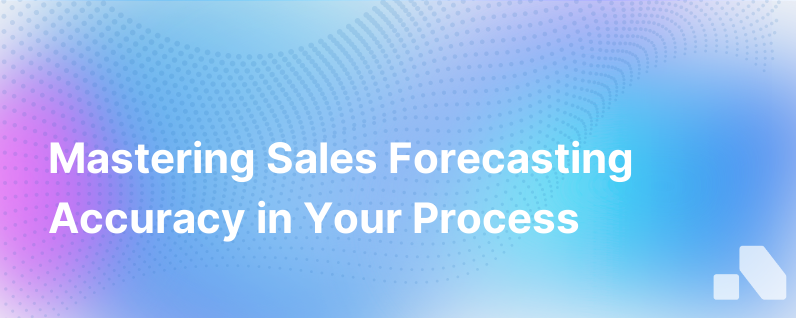
Integrating accurate forecasting into your sales process is akin to setting the sails correctly for a voyage across the business ocean. While the waters will undoubtedly be unpredictable, a good set of sails that catches the economic winds can guide your ship - your business - towards the desired destination: growth and sustainability.
In a world overwhelmed with data, tools, and methodologies, creating a sales forecast that you can rely on might seem daunting, especially for those just dipping their toes into the sales forecasting ocean. But fear not. Below is a comprehensive guide designed to demystify the process and provide you with actionable steps to build accurate forecasting into your B2B sales process.
Understanding Sales Forecasting
Before we dive into the 'hows', it's vital to grasp the 'whats' and 'whys'. Sales forecasting is the process of estimating what your business’s sales are going to be in the future. This is not a mere speculative exercise; it's an informed prediction based on historical sales data, market analysis, and a clear understanding of your sales pipeline.
The functionality of an accurate sales forecast is multi-layered. It enables you to make informed decisions on budgeting, planning, hiring, resource management, and growth strategies. This prevents over-hiring, stockpiling inventory, or cash flow problems due to an uninformed anticipation of revenues.
Now, let's discuss how to weave accurate forecasting into the very fabric of your sales process.
Step 1: Historical Data Analysis
You can't know where you're going if you don't know where you've been. Start with examining historical sales data to identify past trends, seasonality, sales cycle lengths, and win rates. This analysis is vital for setting the baseline from which to draw parallels and note variances for future forecasting.
Step 2: Establish a Consistent Sales Process
For a forecast to be accurate, the sales process generating the numbers must be systematic and repeatable. Align your sales stages with your buyer's journey for a realistic representation of the progression of deals through the pipeline. This consistency enables you to predict the outcomes with higher accuracy.
Step 3: Train and Engage Your Sales Team
The salespeople are your on-ground forecasters who can provide qualitative insights that complement the quantitative data. By training them on the importance of CRM hygiene and the methodology of forecasting, their input becomes an integral part of the forecast's accuracy.
Step 4: Leverage a Robust CRM
A customer relationship management (CRM) system is the backbone of effective sales forecasting. It houses the data points for both current pipeline and historical sales. Leverage a CRM equipped with forecasting tools that can compile this data and automate as much of the forecasting process as possible.
Step 5: Choose the Right Forecasting Method
There are various forecasting methods to choose from:
- Qualitative: Reliant on expert opinions and non-quantifiable information.
- Time Series Analysis: Based on past sales data, assuming past patterns are consistent.
- Causal Models: Assumes that sales are affected by factors outside of time, such as economic conditions or marketing efforts.
- Pipeline-Focused: Based on an in-depth analysis of the current sales pipeline and opportunities in various stages.
The complexity of your business will determine which method works best, or you might leverage a combination.
Step 6: Prioritize Forecast Accuracy Metrics
Always have clear metrics in place to measure forecast accuracy. Frequently review how actual sales figures compare to the forecast for a given period. Use metrics like:
- Forecast Accuracy: (Actual Sales - Forecasted Sales) / Forecasted Sales
- Mean Absolute Percentage Error (MAPE)
- Weighted Pipeline Values: Considering deal probabilities in different stages. This evaluation will help adjust forecasting models for increased accuracy.
Step 7: Review and Adjust Regularly
A rigid forecast is a broken one. Market conditions change, and your forecast must adapt to continue being pertinent. Regularly revisit your forecasting strategy - monthly or quarterly - to tweak assumptions and methodologies in line with new data.
Step 8: Integrate Artificial Intelligence (AI)
Artificial Intelligence is revolutionizing how businesses forecast. AI-driven tools can process vast swaths of data and historical patterns to identify trends and outliers that might be missed by human analysis. Integrating AI can take your forecasting accuracy to the next level.
Step 9: Align with Marketing and Customer Success
Sales don't occur in a vacuum. Aligning with your marketing and customer success teams for insights on lead quality, customer health, and market trends can further sharpen the accuracy of your forecast.
Step 10: Promote a Culture of Accountability
Accuracy in forecasting stems not only from systems and data but also from the people who drive them. Promote a culture where accurate forecasting is given weight and accountability is shared across teams. Reward accuracy and manage expectations realistically.
Conclusion
An accurate sales forecast is not just necessary; it's strategic. It encompasses data analysis, technology, methodologies, and the qualitative insights of a well-trained sales team. The dynamism involved in the process ensures that your business can anticipate changes, plan proactively, adapt to market behaviors, and ultimately sail your ship towards profitable shores.
As a reminder, while this guide offers a solid framework, the integration of a sophisticated AI platform like Aomni can streamline and significantly enhance the accuracy of your forecasting process. With tools designed to automate data analysis and provide real-time insights, platforms like Aomni can ensure that your sales forecasts are not just numbers but navigation charts plotted with precision and strategic foresight.